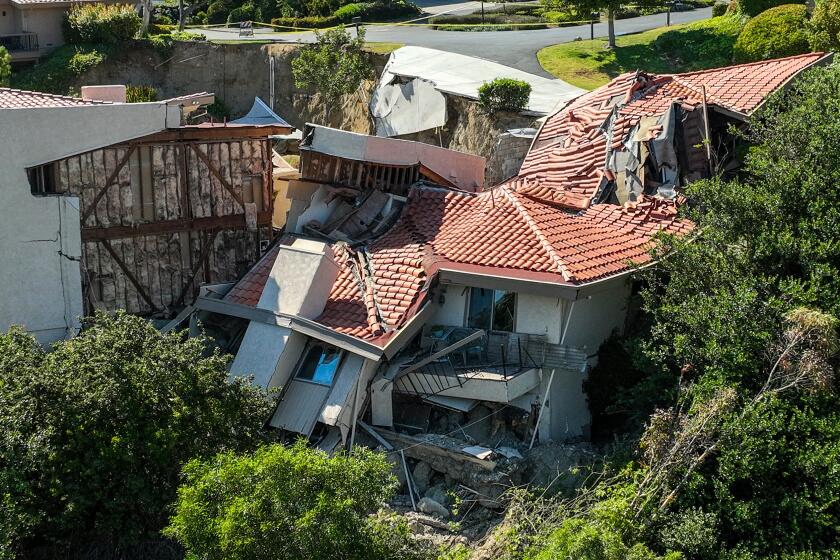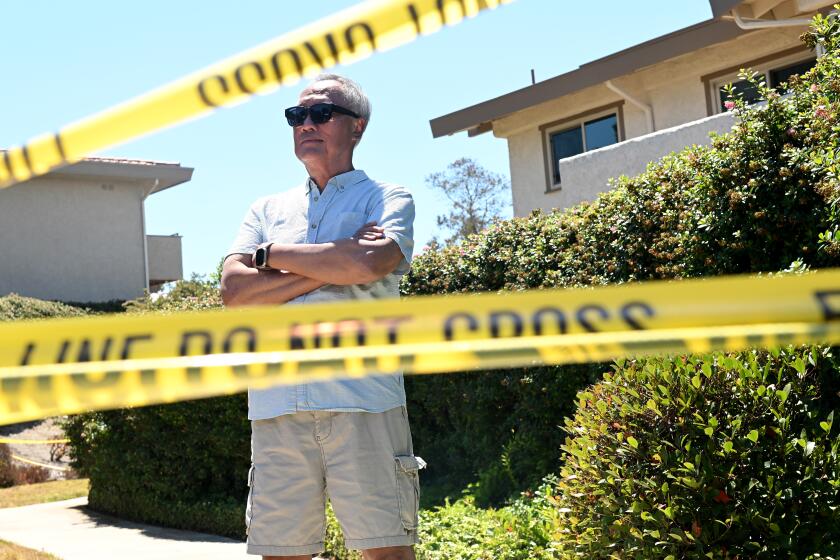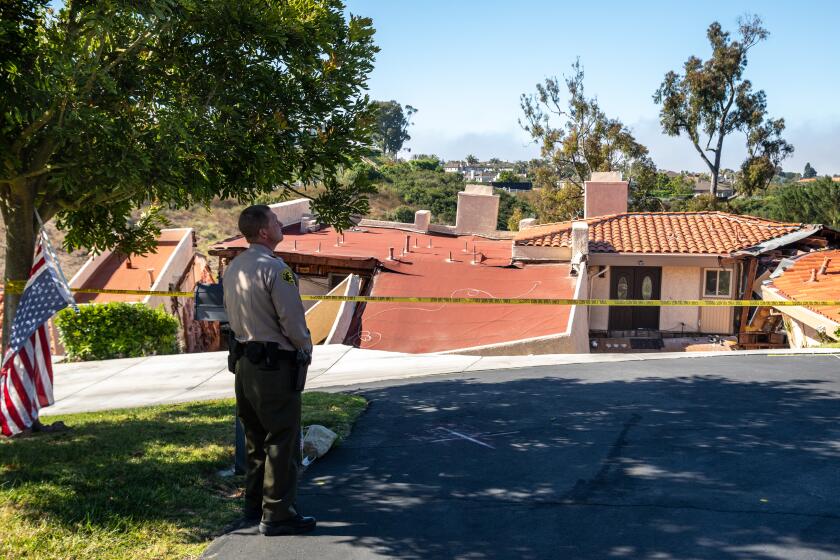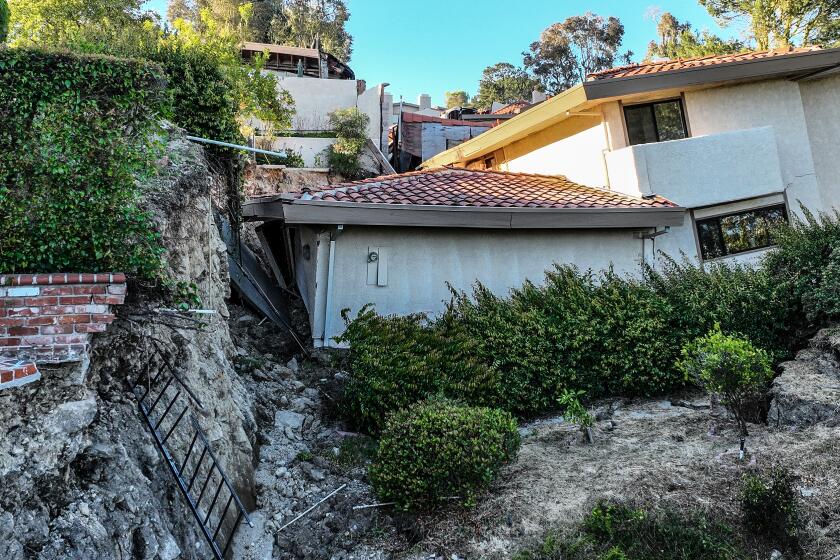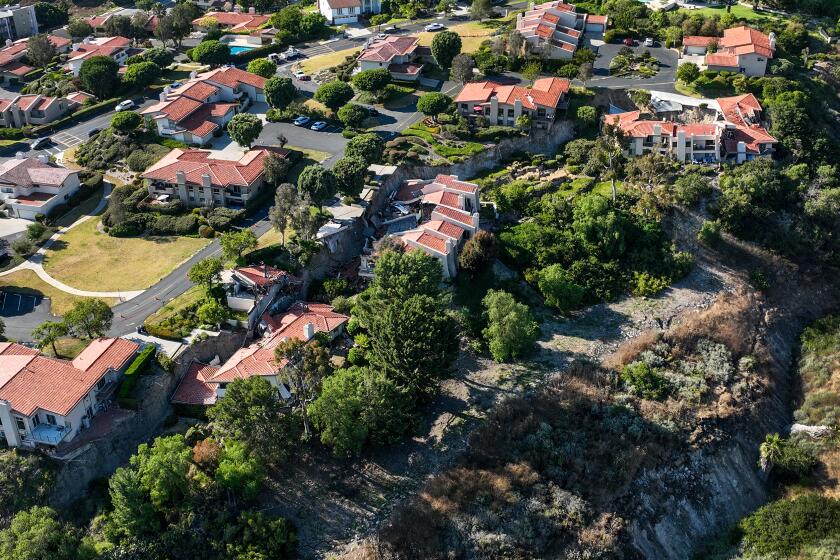Forced from homes by Rolling Hills Estates landslide, weary residents could wait weeks for answers
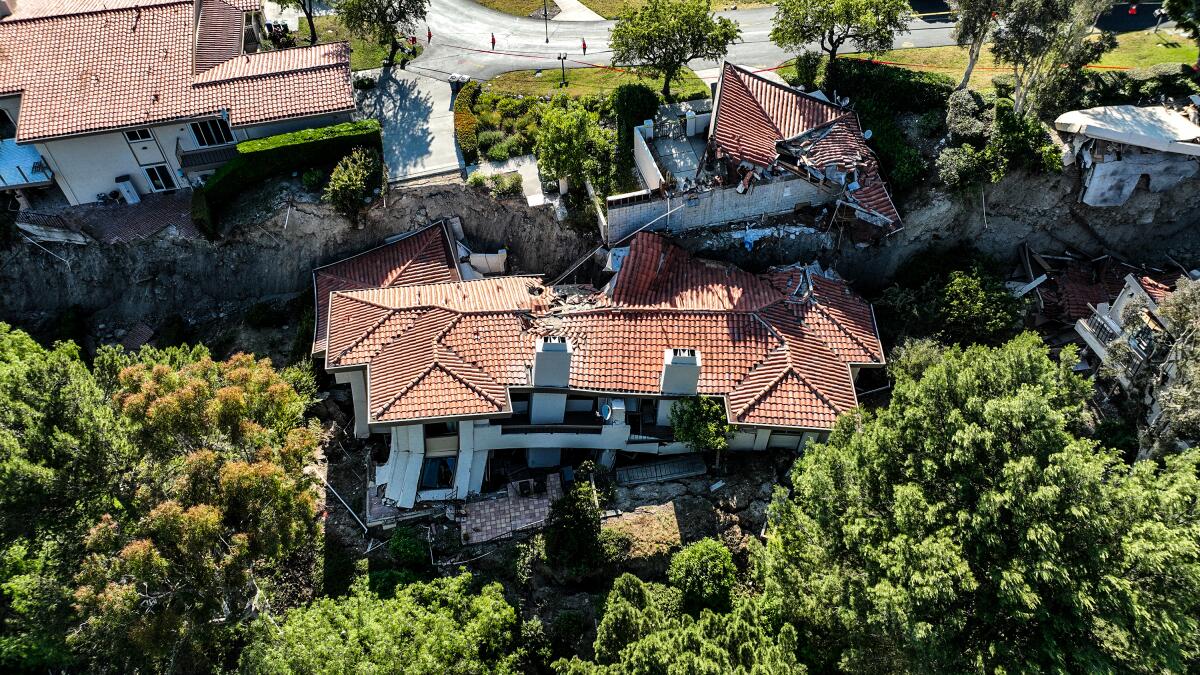
It’s been nearly two weeks since Jooyun Lee and her family were evacuated from their Rolling Hills Estates home as their neighbors’ townhouses slid toward the bottom of the canyon, carried away by a collapsing hillside.
Every day, she wonders: “When are they going to call us and tell us we can move back?”
Lee and her family are among the residents of five units evacuated days after a major landslide collapsed many of her Peartree Lane neighbors’ homes, forced out when officials found a broken sewer line caused by the land movement. Her property wasn’t directly damaged, but it’s been deemed unlivable in the near term until the sewer is fixed.
“We’re just waiting,” Lee said Friday. “We need more information.”
Two weeks since the first set of residents were evacuated July 8, little is known about what caused the slide that destroyed at least eight homes — collapsing roofs, cracking driveways and splitting open walls — and left others nearby feeling like they’re living on the edge.
And now, officials are warning that it could be up to two months before the geological experts evaluating the landslide will have any preliminary results, leaving residents to wait for answers about the landslide’s cause, the street’s future stability, any necessary mitigation — and for some, whether they can ever return home.
Five more homes on Peartree Lane in Rolling Hills Estates have been evacuated after a sewer line broke in the landslide, which had already collapsed multiple homes.
“Oh my goodness,” Lee said, surprised by that timeline. “I thought it would maybe take a week, maybe.”
Lee is staying with her family of four in a Torrance hotel paid for with emergency funds from the city of Rolling Hills Estates, which she said has been fine for the last few days.
But she wasn’t prepared for months.
“I didn’t think it was going to be this bad,” Lee said. She acknowledged that she’s among the most fortunate neighbors, with her home still standing, but said it’s still hard not knowing what will come next.
In total, 17 homes on Peartree Lane remain evacuated as officials still call the major landslide an “active situation.” On July 8, the first 12 homes on the block — most of which lined a canyon wall and are now completely ruined — were evacuated and red-tagged. The last five evacuations, including Lee’s home, were ordered July 11 after the broken sewer line was discovered.
Many homeowners and residents had been hanging their hopes on finally getting answers from a geologist hired by the homeowners association to investigate the land movement, but now they feel further in limbo.
“It just makes our emotions toggle between optimistic and taking steps back,” said David Zee, whose home was deemed unsafe to enter July 8 because of foundation concerns but remains standing. We’re “just trying to put together a mosaic of how long it could potentially take. When I heard potentially eight weeks of monitoring [by the geologist] … that’s going to take us to middle of September.”
He’s said he’s been trying to stay positive, but realizing how long this process could take was tough to hear.
Just the roof of Weber ‘Wei’ Yen’s home is visible from his street in Rolling Hills Estates. He worries over the mementos he may never get back.
“I kind of walked away somewhat disappointed,” Zee said. “But it was good information — more information is always a good thing.”
City officials said Thursday that the community’s homeowners association had hired GMU Geotechnical, an Orange County firm that specializes in geotechnical, structural, pavement and related engineering services, to investigate the landslide on Peartree Lane. The firm began work Wednesday, city officials said, and that “work will be ongoing and a specific timeline for completion is unknown,” according to the city’s update late Thursday.
But multiple residents who attended a virtual meeting with GMU representatives this week told The Times that the experts warned them it could be two months before they get preliminary results. And even then, additional testing or analysis might be necessary to draw conclusions.
The management company for the neighborhood’s two homeowners associations, Scott Management, declined to comment or respond to questions from The Times on the contract. A geologist with GMU deferred questions to attorney Michael Rabkin, who also did not respond to multiple requests for comment from The Times.
Two people were arrested Thursday morning in Rolling Hills Estates after deputies say they attempted to burglarize evacuated homes, then tried to escape into the landslide area.
Zee said he’s glad the geological work is getting started, but worries about how long it will take to get any hillside supports in place, if needed.
“I get the order of operations, but at the same time — how can we speed this up?” Zee said. “Our main objective is to be able to move back. What does that look like and how long does that take?”
“There’s still a lot of uncertainty and unknowns,” he said.
Lee said she and her family haven’t found any cracks in their home, which sits on the opposite side of the street from the collapsing hillside, so they are still planning to return once the sewer is fixed. But she said there’s no indication when that will be.
She and her neighbors also have concerns about the stability of the street, after finding new cracks in the asphalt.
“We are very concerned about the road,” Lee said, noting it’s the only way in and out of their cul-de-sac. We’re “just taking it day at a time and trying to adjust.”
As a Rolling Hills Estates hillside further collapses, homeowners without special coverage are unlikely to get any financial assistance from their home insurers.
Geological experts have said that thorough landslide evacuations take time. El Hachemi Bouali, an assistant professor of geosciences at Nevada State University, who has studied land movement in the Palos Verdes peninsula, said the eight-week timeline given to residents is understandable.
“There is a lot of work to be done to determine exactly how a landslide occurred,” Bouali said. “Landslides are complicated because there are many factors at play.”
He said the logical first step in the investigation would be boring into the earth, to see how the ground’s layers are distributed and if any are saturated with water. Multiple residents said this was how GMU’s team planned to begin work on their street.
“Boring far enough down will allow geologists to find the slip surface, or the surface where everything above it has moved and everything below it has not moved,” Bouali said. “This can help determine the landslide cause.”
He couldn’t give a more specific estimate of when that might be determined, but said he wouldn’t be surprised if water was a factor in the land movement, something city officials have also mentioned. California officials had also warned about the threat of deep-seated landslides this spring and summer for those living on hillsides, after the particularly wet winter and early spring.
From the late 1970s to early 1980s, officials monitored the development of Rolling Hills Park Villas, where a landslide has since ruined at least eight homes.
“The Palos Verdes peninsula has been known to be landslide-prone due to the combination of three main factors: relatively steep slopes composed of weak geologic material and seasonal precipitation events,” Bouali said. He said water can further weaken the region’s weak ground, which is particularly an issue on steep slopes.
Although landslides would exist on the Palos Verdes Peninsula with or without development and construction, Bouali said “humans can exacerbate the situation,” as over-steepening slopes, removing earthen material along hills or adding water from leaky pipes or irrigation can destabilize land.
While Peartree Lane residents await the experts’ analysis, many have wondered whether the landslide could have been prevented. The Times recently reported that during the neighborhood’s construction, residents worried about potential drainage issues, and some in recent years have said they remembered some leaking pipes or unaddressed land movement.
Randy Troy, whose home has now mostly collapsed down the canyon wall, said he’s no geological expert but worries something could have been done before this slide.
“This issue didn’t happen in a vacuum on July 8,” Troy said. “There were events leading up to this.”
He remains hopeful the geotechnical firm can help pinpoint exactly what went wrong.
More to Read
Sign up for Essential California
The most important California stories and recommendations in your inbox every morning.
You may occasionally receive promotional content from the Los Angeles Times.
